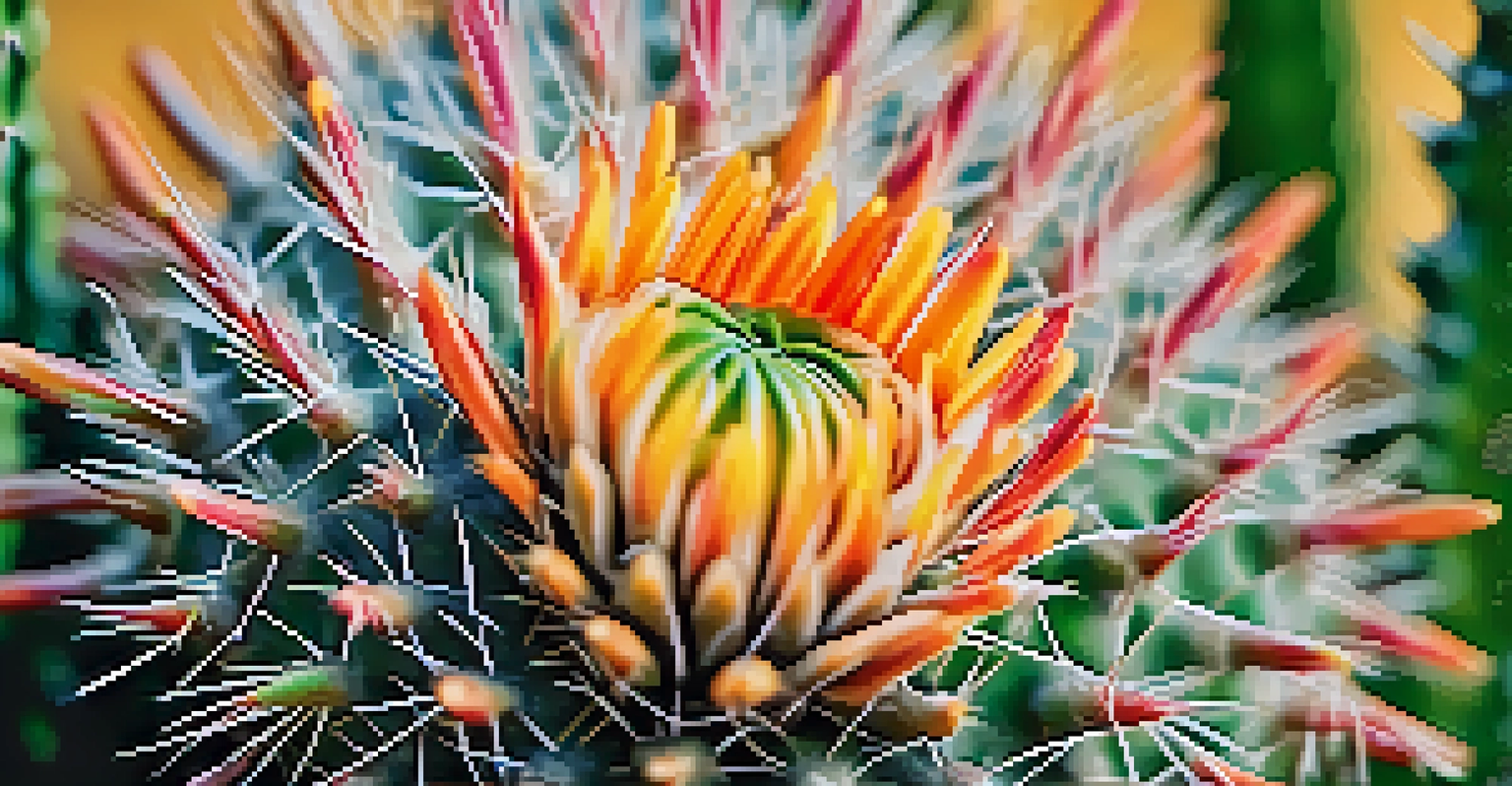Psychoactive Properties of Peyote: What to Expect

What is Peyote and Its Historical Context?
Peyote is a small, spineless cactus native to Mexico and the southwestern United States, most famous for its psychoactive properties. Traditionally, it has been used by Indigenous peoples for spiritual and medicinal purposes for thousands of years. The cactus contains mescaline, a compound responsible for its hallucinogenic effects, which has drawn interest from both researchers and seekers of altered states.
The use of peyote is a sacred tradition for many Indigenous peoples, serving as a bridge to the spiritual world.
Historically, peyote has played a vital role in various Native American religious ceremonies, serving as a means to connect with the spiritual world. Many tribes regard its use as sacred, often incorporating it into their rituals. This cultural significance emphasizes the need to approach its use with respect and understanding.
In contemporary culture, peyote is still used in some religious contexts, particularly by members of the Native American Church. However, its use is regulated, and legal restrictions vary by region. Understanding its background helps contextualize the experiences one might encounter when consuming peyote.
How Does Mescaline Work in the Body?
Mescaline, the active compound in peyote, interacts with serotonin receptors in the brain, particularly the 5-HT2A receptor. This interaction leads to alterations in perception, mood, and cognition, resulting in the distinctive psychedelic experience. Essentially, it changes the way the brain processes sensory information.

The onset of effects typically occurs within 30 to 90 minutes after consumption, with peak experiences often lasting several hours. Users may experience heightened senses, visual distortions, and a sense of euphoria. It’s fascinating how a natural substance can evoke such profound changes in consciousness.
Peyote's Cultural Significance
Peyote has been used for thousands of years by Indigenous peoples for spiritual and medicinal purposes, highlighting its sacred role in various ceremonies.
However, it's important to note that the experience can vary widely among individuals. Factors such as dosage, environment, and mental state play significant roles in determining how one will respond. This variability is a key aspect of the peyote experience, making it both intriguing and unpredictable.
Common Effects of Peyote Consumption
When consuming peyote, users often report a range of effects, which can be both beneficial and challenging. Common experiences include visual and auditory hallucinations, an altered sense of time, and intense emotional responses. Some users describe feeling a deep connection to nature and the universe, which can lead to profound insights.
Psychedelics can facilitate a journey of self-discovery and healing, allowing individuals to confront their deepest emotions.
However, not all experiences are positive. Some individuals may encounter anxiety, confusion, or nausea, especially if they are unprepared for the intensity of the experience. It’s crucial to approach peyote in a safe and supportive environment to minimize potential discomfort.
Recognizing these potential effects can help individuals prepare for their journey. Understanding both the positive and challenging aspects allows for a more grounded and intentional experience, fostering a deeper connection to oneself and the surrounding world.
Setting and Mindset: Their Importance
The setting and mindset are critical components of the peyote experience. A comfortable, safe environment can enhance the positive effects, while an unsettling setting can lead to anxiety or discomfort. Choosing an appropriate location, such as a serene natural setting or a peaceful indoor space, can greatly influence the experience.
Similarly, one's mindset or mental state prior to consumption plays a significant role. Approaching peyote with an open mind and a clear intention can lead to more meaningful insights. Conversely, if someone is feeling anxious or distressed, it may amplify those feelings during the experience.
Mescaline's Effects and Variability
The active compound mescaline alters perception and mood by interacting with serotonin receptors, leading to a unique and highly variable psychedelic experience.
In essence, creating a supportive environment and cultivating a positive mindset are essential for maximizing the benefits of peyote. This holistic approach can transform the experience from merely recreational to a profound journey of self-discovery and connection.
Potential Therapeutic Benefits of Peyote
Research into the therapeutic benefits of peyote and mescaline is gaining traction, showing promise for mental health treatments. Some studies suggest that mescaline may help alleviate symptoms of anxiety, depression, and PTSD, similar to other psychedelics. This has sparked interest in its potential as a tool for healing and personal growth.
One of the most intriguing aspects is its ability to foster deep insights and emotional release. Users often report a heightened sense of introspection, allowing them to confront and process unresolved emotions. This capacity for emotional catharsis can be transformative, leading to lasting changes in outlook and behavior.
While more research is needed to fully understand its therapeutic potential, the existing evidence points towards promising applications in mental health. As societal attitudes toward psychedelics evolve, peyote may play a crucial role in future therapeutic practices.
Legal Status and Ethical Considerations
The legal status of peyote varies significantly around the world, with strict regulations in many countries. In the United States, its use is primarily protected for members of the Native American Church, acknowledging its cultural significance. However, outside of these contexts, peyote is classified as a Schedule I substance, making it illegal for recreational use.
This legal framework raises important ethical considerations, particularly regarding cultural appropriation. Non-Indigenous individuals considering peyote use should approach the subject with respect and sensitivity, recognizing the sacred traditions associated with it. Engaging with Indigenous communities and understanding their perspectives can foster a more respectful approach.
Importance of Setting and Mindset
Creating a safe environment and fostering a positive mindset are crucial for maximizing the benefits of a peyote experience.
Navigating the legal and ethical landscape surrounding peyote requires careful thought and consideration. By being informed and respectful, individuals can honor the traditions associated with peyote while exploring its potential benefits.
Preparing for a Peyote Experience
If you're considering a peyote experience, preparation is key. Start by educating yourself about the effects, risks, and cultural significance of peyote. Understanding what to expect can help mitigate anxiety and enhance the overall experience, ensuring you approach it with the right mindset.
It's also essential to consider the logistics of your experience. Secure a safe and comfortable setting, ideally with a trusted friend or guide who has experience with peyote. This support can be invaluable, especially if the experience becomes intense or challenging, providing reassurance and grounding.

Lastly, reflect on your intentions for the experience. Whether you seek healing, insight, or simply curiosity, having a clear purpose can guide your journey. This intentional approach can help you derive meaningful insights and foster a deeper connection with yourself and the world around you.